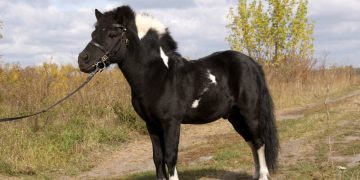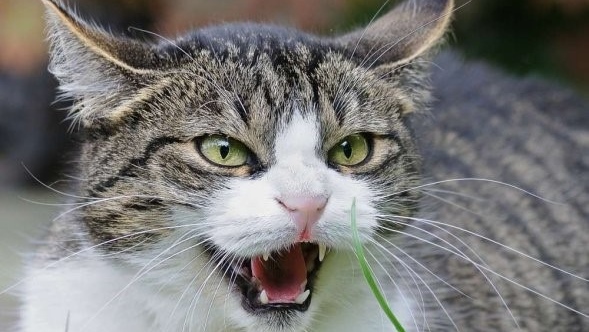Though the house cats we know today have been domesticated for thousands of years, they still retain many innate features of wild felines. Cats in the wild are predators and are hard-wired to attack prey such as birds, mice, and reptiles. But their small stature makes them vulnerable to attack by larger predators such as coyotes, eagles, and owls. Because of this, cats have a natural aggression response to perceived threats.
Aggression in cats is defined as any violent behavior cats may use to protect themselves by intimidating or expressing dominance over another individual, whether human or animal. Most indoor cats do not face the same threats to their safety as their wild ancestors did, but they can still exhibit aggressive behaviors toward people and other household pets when they feel afraid.
It’s crucial to understand your cat’s fear aggression behavior, both to prevent injuries and to keep your kitty feeling safe and comfortable.
What Is Fear Aggression in Cats?
Fear aggression is one of the more common causes of aggressive behavior in cats. This violent behavior is a response to an unfamiliar and potentially threatening stimulus, such as a new person or animal in your cat’s environment or a loud noise nearby.
Fear-based aggression can also develop when a cat has a stressful, unpleasant experience in a certain location and develops a negative association with that place. For instance, at a grooming facility where the cat may have been physically restrained.
Signs of Fear Aggression in Cats
Cats experiencing fear aggression may run, fight, or freeze. Pet parents may notice:
Dilated pupils
Bared teeth
Ears flat against the head
Limbs and tail tucked under the body
Body kept low to the ground or angled away from the stimulus
Fur standing on end
The greater the perceived threat, the stronger the fear response will be. If the cat chooses to fight, either because they cannot escape or because they have learned that acting violently removes the threat, they may:
Swipe or bat
Bite
Hiss, spit, or growl
Pounce on or chase another pet or person
Causes of Fear Aggression in Cats
Fear aggression in cats can have a variety of causes. Common stimuli for fear aggression in cats include:
Unfamiliar people or animals getting too close to the cat
Being placed in an environment the cat associates with a past negative experience
Loud, unfamiliar noises (such as a vacuum cleaner)
Any changes to the environment that may frighten a naturally timid or shy cat
How to Deal With Fear Aggression in Cats
There are a few ways pet parents can address fear aggression in cats. No matter which you choose, always keep the foundations of managing aggression in mind:
Reinforcing non-aggressive behavior
Not punishing the cat
Being mindful to not accidentally reinforce the aggressive behavior
Counterconditioning
Counterconditioning is one of the best methods to reduce fear aggression. Counterconditioning involves slowly desensitizing an aggressive cat to the perceived threat over a period of weeks to months.
For example, if the cat is afraid of how the vacuum sounds and the aggressive behavior starts when the vacuum is 20 feet away, the vacuum could be running 25 feet away while the cat is rewarded for displaying nonaggressive, calm behavior.
Over time, the vacuum could be brought incrementally closer to the cat while consistently rewarding them with a high-value treat for displaying appropriate behavior until they have little to no reaction toward the once-threatening stimulus.
Pureed meat treats, such as Churu, are a great option for rewards because they can be distributed in small amounts at a controlled rate—at fewer than 10 calories per tube! During the counterconditioning process, it’s important to ignore unwanted aggressive behaviors so the cat learns that only the desired nonaggressive behaviors will be rewarded.
Prevention
In some cases, it may be possible to prevent fear aggression. Identifying and avoiding any triggering situations can be useful, such as having visitors keep their distance from a cat whose fear aggression is caused by unfamiliar people.
Learning to recognize the early signs of fear in cats can also be helpful so that counterconditioning and other measures can be instituted quickly and effectively, especially because aggressive fear responses can increase over time. A cat perching in unusual locations when presented with a threatening stimulus, for instance, is showing signs of fear that may escalate to aggression if not addressed.
Calming Products
Some pet parents may find it effective to use a combination of methods to address fear aggression. Calming products such as Feliway pheromone diffusers or prescription diets such as Royal Canin Calm cat food are available. In more severe cases, prescription medications such as fluoxetine and lorazepam are needed. These interventions can decrease fear and anxiety to a manageable level -before instituting desensitization training.
Positive Reinforcement
During the treatment process, cats can be vulnerable as they unlearn negative behaviors. Physical punishment should never be used to correct aggressive behavior; this includes using deterrent techniques such as squirt bottles when they’re acting aggressively. Shouting is also harmful to the cat. Introducing these punishments while the cat is already afraid can worsen the fear response.
Running away or showing fear toward an aggressive cat who is biting, lunging, or swiping should also be avoided, because it teaches the cat that acting aggressively removes the threatening stimulus. Similarly, consoling an aggressive cat may be viewed by the cat as approval of their behavior.
Fear aggression in cats can be a complex issue, and there are many options available to manage fear aggression. Consulting with the cat’s primary veterinarian is crucial to determine what might be most helpful for the cat. Seeking help from a board-certified veterinary behaviorist or a certified International Association of Animal Behavior Consultants (IAABC) professional may also be recommended. Addressing each cat’s unique situation offers the greatest probability of success in resolving fear aggression.

























